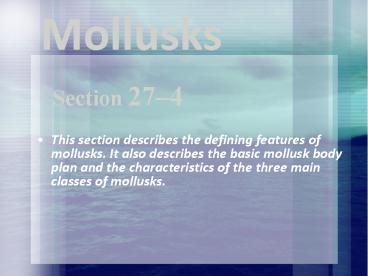Mollusks PowerPoint PPT Presentation
Title: Mollusks
1
Mollusks
Section 274
- This section describes the defining features of
mollusks. It also describes the basic mollusk
body plan and the characteristics of the three
main classes of mollusks.
2
Mollusk
- What Is a Mollusk?
- Mollusks are members of the phylum
- Mollusca .
3
Mollusk
- Circle the letter of each sentence that is true
about mollusks. - They share similar developmental stages.
- They usually have an internal or external shell.
- They are soft-bodied animals.
4
Mollusk
- What is a trochopore?
- It is a larval stage of a mollusk.
5
Form and Function in Mollusks
- What are the four parts of the body plan of most
mollusks? - Foot
- Shell
- Mantle
- Visceral mass
6
What forms do the muscular mollusk foot take?
- Flat structures for crawling, spade shaped,
structures for burrowing, and tentacles for
capturing prey
7
Mollusk
- The thin layer of tissue that covers most of the
mollusks body is called the mantle.
8
Mollusk
- How is the mollusk shell made?
- It is made by glands in the mantle that secrete
calcium carbonate.
9
Mollusk
- Snails and slugs feed using a tongue-shaped
structure known as a(an) radula .
10
Mollusk
- What is a siphon?
- A siphon is a tubelike structure through which
water enters and leaves the body.
11
Mollusk
- Why do land snails and slugs typically live only
in moist places? - They respire using a mantle cavity that has a
large surface area lined with blood vessels, and
the lining must be kept moist so that oxygen can
diffuse across its surface.
12
Mollusk
- How does an open circulatory system carry blood
to all parts of a mollusks body? - Blood is pumped through vessels by a simple
heart. Blood eventually leaves the vessels and
works its way through different sinuses.
13
Mollusk
- A large saclike space in the body is called a(an)
sinus.
14
Mollusk
- Ammonia is removed from the blood and released
out of the body by tube-shaped nephridia .
15
Chapter 27, Worms and Mollusks (continued)
- Circle the letter of each sentence that is true
about mollusk response. - Clams have a simple nervous system.
- Octopi and their relatives have the most highly
developed nervous system of all invertebrates. - Vertebrates are more intelligent than octopi.
16
Mollusk
- Where does fertilization take place in tentacled
mollusks and certain snails? - It takes place inside the body of the female.
17
Mollusk
Class Common Name Description of Shell Examples
Gastropoda Gastropods Shell-less Or single shelled Pond snails, land slugs, sea butterflies, sea hares, nudibranches
Bivalvia Bivalves Two shells that are held together by one or two powerful muscles Clams, oysters, scallops, mussels
Cephalopoda cephalopod Only small internal shells or no shells Octopi, squids, cuttlefishes, nautiluses
18
Mollusk
- Circle the letter of each sentence that is true
about bivalves. - Mussels use sticky threads to attach themselves
to rocks. - Some bivalves feed on material deposited in sand
or mud.
19
Mollusk
- The cephalopod head is attached to a single
- FOOT.
20
Mollusk
- What is a cephalopods foot divided into?
- Tentacles, or arms
21
Mollusk
- What allows squids to locate a wide variety of
prey? - They have large complex eyes that can
distinguish objects as small as 0.5 centimeters
from a meter away.
22
Mollusk
- The only present-day cephalopods with external
shells are - nautiluses .
23
Ecology of Mollusks
- What allows mollusks to inhabit the extreme
environment around deep-sea volcanic vents? - Within the bivalves around these vents are
symbiotic bacteria that extract chemical energy
from compounds in the water. From that energy,
the bacteria produce food molecules that the
mollusks can use.
24
Mollusk
- Why can careful checks of bivalves warn public
health officials of possible health problems to
come? - Filter-feeding bivalves concentrate dangerous
pollutants and microorganisms in their tissues. - Therefore if certain bivalves contain high
levels of pollutants, people are warned not to
eat them.

